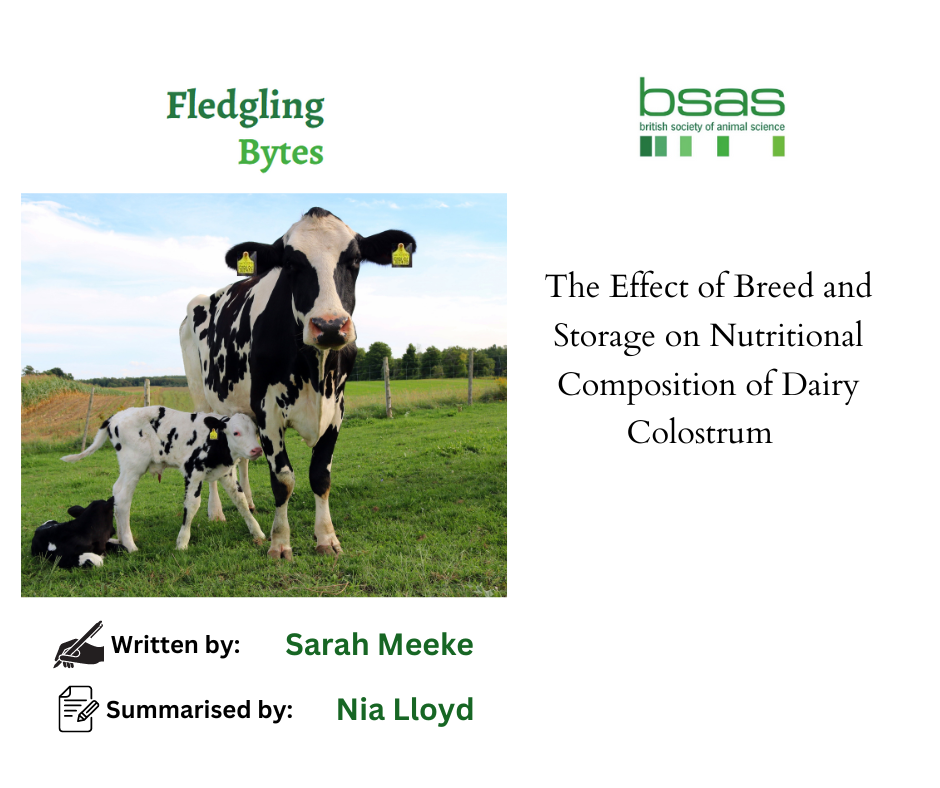
The Effect of Breed and Storage on Nutritional Composition of Dairy Colostrum
This study was completed by Sarah Meeke, College of Agriculture, Food and Rural Enterprise.
Take home message: It is vital that colostrum is collected and sampled for quality quickly after calving and fed immediately to newborn calves, reducing the rate of bacterial colonisation and Immunoglobulin decline. However, correct storage in either a fridge for a short period of time or freezer can be used in a colostrum feeding protocol to ensure calves are receiving the passive immunity they require to be healthy.
The importance of colostrum to a newborn calf cannot be underestimated, with calves suffering from colostrum deprivation significantly contributing to mortality rates and impacting farm profitability. The quality of colostrum is vital and is largely determined by immunoglobulins Ig (IgG), fat and protein concentrations. On farm measurements of colostrum quality are commonly done using a refractometer or colostrometer which are cost effective methods and measures quality by the level of IgG in a sample. High quality colostrum is defined as having a IgG concentration of >50mg/ml (22% brix value) and low quality <50mg/ml (18% brix value). There are several on farm factors that can affect the quality of colostrum and this study aimed to identity colostrum quality, composition and storage techniques in different breeds on Northern Irish farms. Hypothesising that Holstein cows would produce the highest yield but lowest IgG quality colostrum.
Colostrum samples were taken from three farms and each farm had a different breed of cattle; British Frisian, Holstein and Jersey. Colostrum was tested using a refractometer within 12 hours of collection and then split into one of four storage treatments, fridge, freezer, room temperature and pasteurization. A second reading was taken from the fridge and room temperature after 24 hours, day 3 and 7, and the frozen sample was tested following defrosting and pasteurization. A bacterial count using agar plates and colony counter was carried out on colostrum from all three breeds from each sample type. Fresh colostrum samples from each breed were also measured for protein, fat and lactose %. Farmers were also asked a set of herd management questions.
A single factor ANOVA found a significant difference in the colostrum quality of fresh samples between breeds (P = 0.001), measuring at 23.2 IgG, 21.2 IgG and 18.1 IgG for British Friesian, Holstein and Jersey, respectively. Colostrum quality significantly (P = <0.01) declined between the fresh measurement and day 7 of sampling protocol (22% vs 18%). Pasteurisation did not have a significant impact on IgG levels (P= 0.1), similarly defrosting samples did not result in a significant difference (P =0.1) in quality in any of the breeds. However, the Holstein sample dropped from 23% at fresh to 20.7% after storage which is below the desired threshold of high quality for brix measurements. Bacterial count was greatest in room temperature samples compared to fridge, freezer and pasteurisation and the lowest bacterial count was found in the fresh sample. Although there was a numerical difference of up to 6 days between the dry period length of breeds, there was no statistical difference (P=0.1).
In conclusion, this study has demonstrated the effect room temperature has on IgG levels and the differences in colostrum quality between breeds of dairy cattle. The study has also been successful in demonstrating the decline in colostrum quality over time and on one occasion between freezing and defrosting of a sample. However, the study would have liked to have measured additional factors such as diet, dam age and health status.
Written by Nia Lloyd, Lecturer at Aberystwyth University.
